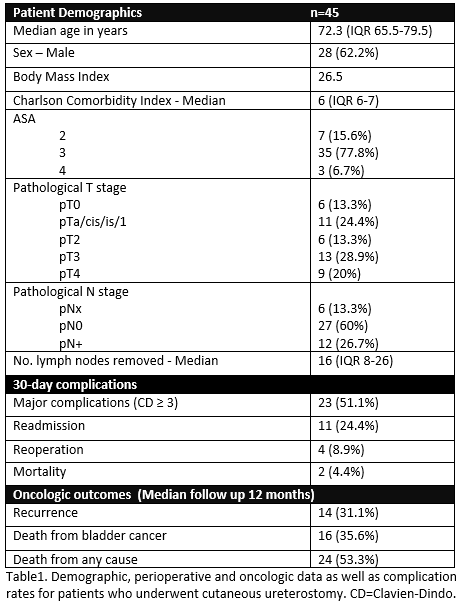Back
Introduction: The use of intestine for urinary diversion following radical cystectomy (RC) entails perioperative morbidity and the potential for long-term metabolic abnormalities. Limited reports exist on cutaneous ureterostomy (CU), a diversion which obviates the need for bowel interposition. Herein, we report a contemporary series of CU with RC from a tertiary referral center.
Methods: We retrospectively identified patients who underwent RC with CU for bladder cancer at Mayo Clinic between 2016-2021. Clinicopathologic and perioperative characteristics were analyzed using standard descriptive statistics.
Results: A total of 45 patients underwent RC with CU at our institution during this timeframe. Demographics are provided in Table1. Median operating time was 282 minutes (IQR 214-288). Median estimated blood loss was 500mL (IQR 250-900). Surgery was done using open and robotic approach in 31 and 14 patients, respectively. Twenty-five patients had a unilateral CU (placed in the ipsilateral hemiabdomen): 8 with a solitary kidney, 2 transplant kidneys, 1 contralateral ureteral ligation due to an atrophic kidney, and 14 who underwent contralateral nephroureterectomy with RC. Of the remaining 20 patients with bilateral renal units, the ureters were either brought together using Wallace technique and a single stoma (n=11) or separately brought to each side of the hemiabdomen (n=9). Median time to flatus, regular diet, and bowel movement were 3 (IQR 3-4), 3 (IQR 3-4), and 5 days (IQR 3-7), respectively. Median length of stay was 5 days (IQR 4-7). Readmission rate within 30 days was 24% (11/45), while 51% (23/45) experienced a high-grade complication (Clavien-Dindo = 3) within 30 days of surgery. All patients but one were managed with chronic indwelling stents. At a median follow-up of 12 months (IQR 0.5, 2.1), 3 patients developed stomal stenosis requiring revision and 1 required percutaneous nephrostomy drainage. Median GFR declined from 50 mL/min (IQR 30-61) at baseline to 40 (IQR 32-60) at the median follow-up of 12 months.
Conclusions: In a highly comorbid, relatively elderly bladder cancer cohort undergoing RC, the use of CU was associated with expeditious surgery and postoperative recovery. CU represents an option for urinary diversion in select patients at particularly increased risk for bowel diversion with RC. SOURCE OF
Funding: None

Moderated Poster Session
Session: MP42: Trauma/Reconstruction/Diversion: Ureter (including Pyeloplasty) & Bladder Reconstruction (including Fistula), Augmentation, Substitution, Diversion
MP42-15: Cutaneous Ureterostomy Following Radical Cystectomy for Bladder Cancer: A Contemporary Series
Saturday, April 29, 2023
1:00 PM – 3:00 PM CST
Location: S505

Reza Nabavizadeh, MD (he/him/his)
Mayo Clinic Rochester, Minnesota
Poster Presenter(s)
Introduction: The use of intestine for urinary diversion following radical cystectomy (RC) entails perioperative morbidity and the potential for long-term metabolic abnormalities. Limited reports exist on cutaneous ureterostomy (CU), a diversion which obviates the need for bowel interposition. Herein, we report a contemporary series of CU with RC from a tertiary referral center.
Methods: We retrospectively identified patients who underwent RC with CU for bladder cancer at Mayo Clinic between 2016-2021. Clinicopathologic and perioperative characteristics were analyzed using standard descriptive statistics.
Results: A total of 45 patients underwent RC with CU at our institution during this timeframe. Demographics are provided in Table1. Median operating time was 282 minutes (IQR 214-288). Median estimated blood loss was 500mL (IQR 250-900). Surgery was done using open and robotic approach in 31 and 14 patients, respectively. Twenty-five patients had a unilateral CU (placed in the ipsilateral hemiabdomen): 8 with a solitary kidney, 2 transplant kidneys, 1 contralateral ureteral ligation due to an atrophic kidney, and 14 who underwent contralateral nephroureterectomy with RC. Of the remaining 20 patients with bilateral renal units, the ureters were either brought together using Wallace technique and a single stoma (n=11) or separately brought to each side of the hemiabdomen (n=9). Median time to flatus, regular diet, and bowel movement were 3 (IQR 3-4), 3 (IQR 3-4), and 5 days (IQR 3-7), respectively. Median length of stay was 5 days (IQR 4-7). Readmission rate within 30 days was 24% (11/45), while 51% (23/45) experienced a high-grade complication (Clavien-Dindo = 3) within 30 days of surgery. All patients but one were managed with chronic indwelling stents. At a median follow-up of 12 months (IQR 0.5, 2.1), 3 patients developed stomal stenosis requiring revision and 1 required percutaneous nephrostomy drainage. Median GFR declined from 50 mL/min (IQR 30-61) at baseline to 40 (IQR 32-60) at the median follow-up of 12 months.
Conclusions: In a highly comorbid, relatively elderly bladder cancer cohort undergoing RC, the use of CU was associated with expeditious surgery and postoperative recovery. CU represents an option for urinary diversion in select patients at particularly increased risk for bowel diversion with RC. SOURCE OF
Funding: None

